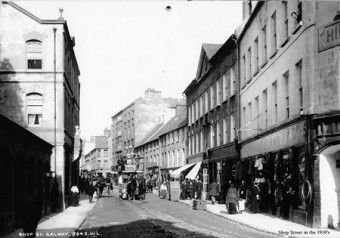Search Results for 'High Sheriff'
4 results found.
Stormy summers on the Clare coast

One of the most interesting hotels in Ireland is the Falls Hotel, Ennistymon, Co Clare. Apart from its spectacular setting overlooking the River Inagh as it cascades over wide ledges almost immediately outside its door, this distinctive building conceals within its walls an 18th century mansion, and a late medieval castle. It was the home of the one-time wealthy Macnamaras, landlords of vast Clare territories. The last of the clan to hold any real status was Henry Valentine Macnamara (known as Henry Vee), the High Sheriff of Co Clare, and a character to be reckoned with. One December morning in 1919, Henry Vee and friends (who included a British army officer and a Lady Beatrice O’Brien), set out in a convoy of cars for a woodcock shoot in the Burren.
Clifden’s Parisian boulevards

The man who opened Connemara to the traveller, and built an infrastructure to encourage trade and commerce in what was a wilderness of bog, mountain, and a rocky sea coast, was the Scottish engineer Alexander Nimmo. He was originally commissioned to investigate the possibility of draining the bogs, and replace them with a landscape of arable land suitable for farming. But Nimmo was the original man who thought outside the box. In his report of 1812 he outlined the total neglect of the region which had about 30,000 inhabitants, mostly living along her coast, eking out a bare subsistence livelihood. But he saw huge potential in the natural wealth of Connemara for tourism, and limited industry. He reported that there were large quantities of fish in its lakes and sea, and abundant seaweed for manure and for the manufacture of kelp. Its agriculture was undeveloped, its bogs badly harvested. All this neglect could be remedied
Humanity Dick’s last battle
Humanity Dick Martin’s daughter, Harriet Letitia, wasn’t the only one to write about her father’s victory at the notorious Galway election of 1826. It was such a blatant hijack of votes, a total fraud, and swindle, that it outraged the investigating committee from the House of Commons some months later. But Martin was desperate. Despite his enormous estates, consisting of 196,540 acres, virtually the entire territory of Connemara stretching westwards from Galway, he was deeply in debt. He was a useless landlord in the sense that his collection of rents was haphazard and irregular. He had a generous heart. He did not press his tenants for money.
Two faces lean out of the window...

Before the disbandment of the Connaught Rangers in 1922, it was customary on Sunday mornings for the Protestant members of this proud regiment to march in full uniform, with bagpipes and drums, out of Renmore barracks, through the town to attend service at St Nicholas Collegiate Church. It was an exciting spectacle for many of the girls of Galway. They would gather in small groups, or lean from windows, to catch the eye of a handsome soldier. Monsignor Considine would often precede the parade waving at the girls to go away. Pointing up to the girls at the windows (many of them apprentices, who lived above the shops whose trade they were learning), telling them ‘Not to be looking at those Protestant soldiers’. Most girls would quickly hide, and once the monsignor had passed, pop their heads out again.

